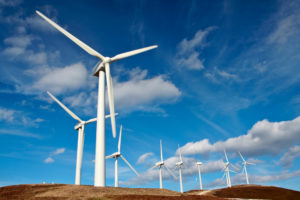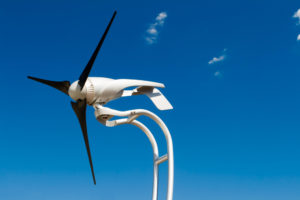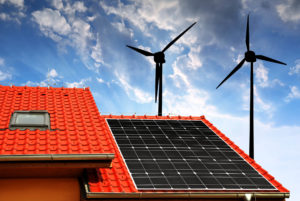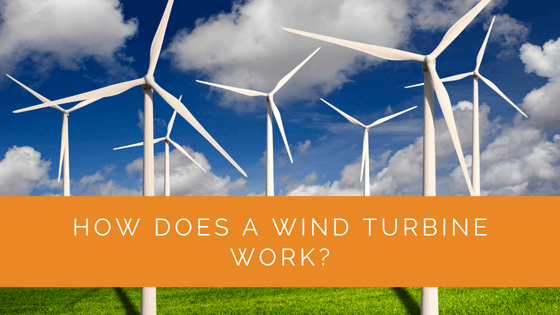In today’s day and age, wind energy has surpassed solar energy as one of the fastest-growing renewable energy sources. Throughout history, humans have used wind power to their advantage. As a result, wind turbines have become more ubiquitous in our landscape.
Turbines are nearly entirely large-scale wind systems manufactured by commercial and industrial enterprises. As a result, the typical individual is less likely to understand how a wind turbine functions. Continue reading and learn more about wind turbines and how they generate power.
Contents
Key Takeaways
- Wind turbines generate electricity by harnessing the kinetic energy from the wind. The wind turns the turbine’s blades, which then spin a generator to produce electrical power, with higher wind speeds leading to more energy production.
- Wind turbines have several key components, including rotor blades, a gearbox, a nacelle to protect internal components, and a generator. These components work together to convert wind energy into electricity efficiently.
- Wind speed and direction significantly affect a wind turbine’s electricity production, with turbines shutting down in high winds to prevent damage and low winds having limited energy generation capacity. Proper maintenance and research are crucial to advancing wind-based energy solutions for a sustainable future.
Wind Turbine Function
Wind turbines operate on a fairly basic principle: the wind moves the blades, causing the vertical axis to revolve, which is connected to wind turbine generators that create DC (direct current) energy. This DC is later converted to AC (alternating current) through an inverter to power homes and commercial properties.
The higher the wind’s speed, the more kinetic energy it produces, and consequently, the more powerful an energy source it becomes. As a result, we often find industrial-scale wind farms with tall towers and enormous rotor blades built in areas receiving high winds, such as the countryside, even offshore.
The efficiency of a turbine is determined by how successfully it catches wind power and converts it into rotational torque, which may subsequently drive electrons out of the generator and onto the grid.
The towers are often built of steel, but the blades, which must be sturdy yet light enough to revolve in the wind, can be made of glass fiber or reinforced polyester.

Step 1: The Wind Hits the Turbine
It is impossible to harness wind energy until the wind blows. By striking the blades, the wind spins the rotor. The blades are fashioned like an airfoil, similar to a plane’s wings, and create lift. Producing electricity depends on this factor.
Because the rotor blades continually move, the wind strikes them at an angle. The blades are constructed with this, including twists and angles to capitalize angular momentum and catch as much energy as possible.
Step 2: The Turbine Begins to Spin
Wind energy is transmitted into the gearbox after the turbine is rotating. Because wind turbines work quite slowly to create power, gears are required to increase the torque. A low-speed shaft and a high-speed shaft make up the gearbox.
Low-speed shafts connect to high-speed shafts, which connect to blades. A high-speed shaft connects to the generator.
Step 3: Energy!
The gearbox acts as a funnel, channeling a significant amount of electricity into a small rotor that rotates an electromagnet within the generator. The generator then produces electricity when mechanical power from the wind is converted into electrical energy.
Step 4: Power Transfer
The power is routed by wires within the tower to a transformer at the wind turbine’s base. Most wind turbine generators produce alternating currents. Therefore, switching from DC to AC is not required as in a typical power plant. For large-scale distribution, the transformer enhances the voltage.

Wind Speed and Direction
Wind velocity and direction significantly impact the produced electricity that wind turbines generate. Stronger winds provide more power, but there is a limitation.
Turbines shut down when wind speeds exceed 55 mph to avoid damage, and severe storm winds have destroyed turbines. Similarly, low wind speeds have minimal capacity to generate energy. When wind speeds fall below 8 mph, most wind turbines stop down.
Wind turbines operate effectively when the breeze is perpendicular to the surface of the rotors or if the blades turn at an angle of 180 degrees.
What Elements Make Up a Wind Turbine?
A wind turbine appears to have a basic design from the outside. Isn’t it just a huge fan? Wrong.
A wind turbine’s design must incorporate many physics, engineering, and fluid dynamics for the highest efficiency. They are complicated pieces that work together to extract as much energy as feasible.
Rotor and Blades
The blades are the most noticeable component of an offshore or land-based wind turbine. Most feature three blades, while specific designs call for only two. The blades are designed like an airfoil, similar to a plane’s wings. Because its aerodynamic design generates more lift than drag, the blades rotate.
Gearbox
Wind turbines revolve too slowly to generate electricity on their own. A gearbox is required to ramp up the spinning of the generator to produce power.
A low-speed shaft and a high-speed shaft make up the gearbox. The rotor and low-speed shaft are linked to the high-speed shaft, which is linked to the generator. The gearbox ensures that the generator receives enough rotational energy to create electricity.
Nacelle
The box behind the rotors and blades is known as the nacelle. It shields the gearbox, brakes, and generator from the weather.
Generator
The generator, as the name suggests, is where power is generated. The rotor’s torque is boosted in the gearbox and subsequently turned into electrical energy. Like most electrical generators, the generator of a wind turbine rotates a rotor coupled to an electromagnet, which creates electricity.

Wind Turbine Generators’ Importance
Because it turns mechanical energy into electricity, the generator is an essential wind turbine component. Wind power generation would be impossible if the generator failed. As a result, generators must be kept in good operating order. Routine maintenance and repairs are the most significant ways to achieve this.
A robust preventive maintenance program may extend the life of wind turbine gear while saving money. Effective preventative maintenance techniques enable wind turbine operators to identify and fix concerns before they become catastrophic.
The United States boasts of being one of the world’s fastest-growing markets for wind-based energy. The Department of Energy undertakes rigorous research and analysis for technological innovations to maintain competency.
Expert Insights From Our Solar Panel Installers About How a Wind Turbine Works
Understanding the mechanics of wind turbines is crucial for optimizing their performance. The conversion of kinetic energy from wind into mechanical energy and subsequently into electrical energy involves intricate components working seamlessly together.
Senior Solar Technician
Wind turbines are designed to maximize energy capture by harnessing wind at various speeds and directions. Proper maintenance and understanding of each component’s role can significantly enhance their efficiency and longevity.
Lead Solar Installer
Factors like wind speed and direction play a critical role in energy production. By situating turbines in optimal locations and ensuring they are well-maintained, we can maximize the benefits of wind energy.
Solar Energy Consultant
Conclusion
Wind power is now more practical for individuals who live in remote places with a good, powerful, and consistent wind source. The scale of the array required to provide adequate power for household consumption is sometimes too expensive for anybody else.
However, significant advancements and research are being conducted to make wind one of the most popular energy resources in the world.
There might soon be turbines that could be utilized in our towns and cities as solar electricity is used now. These ‘small wind turbines’ could usher in the sustainable trend of micro-generated electricity sufficient for modest homes and properties.
About the Author
Solar Panels Network USA stands at the forefront of solar energy solutions, driven by a team of seasoned solar engineers and energy consultants. With over decades of experience in delivering high-quality solar installations and maintenance, we are committed to promoting sustainable energy through customer-centric, tailored solutions. Our articles reflect this commitment, crafted collaboratively by experts to provide accurate, up-to-date insights into solar technology, ensuring our readers are well-informed and empowered in their solar energy decisions.

